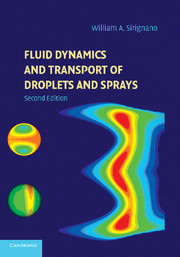Book contents
- Frontmatter
- Contents
- Preface
- Nomenclature
- 1 Introduction
- 2 Isolated Spherically Symmetric Droplet Vaporization and Heating
- 3 Convective Droplet Vaporization, Heating, and Acceleration
- 4 Multicomponent-Liquid Droplets
- 5 Droplet Behavior under Near-Critical, Transcritical, and Supercritical Conditions
- 6 Droplet Arrays and Groups
- 7 Spray Equations
- 8 Computational Issues
- 9 Spray Applications
- 10 Spray Interactions with Turbulence and Vortical Structures
- 11 Film Vaporization
- 12 Stability of Liquid Streams
- Appendix A The Field Equations
- Appendix B Conserved Scalars
- Appendix C Droplet-Model Summary
- Bibliography
- Index
12 - Stability of Liquid Streams
Published online by Cambridge University Press: 05 June 2012
- Frontmatter
- Contents
- Preface
- Nomenclature
- 1 Introduction
- 2 Isolated Spherically Symmetric Droplet Vaporization and Heating
- 3 Convective Droplet Vaporization, Heating, and Acceleration
- 4 Multicomponent-Liquid Droplets
- 5 Droplet Behavior under Near-Critical, Transcritical, and Supercritical Conditions
- 6 Droplet Arrays and Groups
- 7 Spray Equations
- 8 Computational Issues
- 9 Spray Applications
- 10 Spray Interactions with Turbulence and Vortical Structures
- 11 Film Vaporization
- 12 Stability of Liquid Streams
- Appendix A The Field Equations
- Appendix B Conserved Scalars
- Appendix C Droplet-Model Summary
- Bibliography
- Index
Summary
Introduction
It is intended herein to present the current status of the fundamental understanding about the liquid-atomization processes for various injection configurations. The limitations of the theory and the need for future work will be made apparent. This chapter is not intended to be a guide for the practicing engineer; the current state of the art is based on empirical approaches that are discussed in Chapter 1. Rather, this chapter reviews theoretical research that should eventually lead to improved design methodology and design tools for liquid-atomization systems. Other overviews of the theory can be found in Lefebvre (1989), Bayvel and Orzechowski (1993), Sirignano and Mehring (2000, 2005), and Lin (2003).
The atomization problem could be divided according to three subdomains of the fluid mechanical field. The upstream subdomain lies within the liquid-supply piping, plenum chamber, and orifice (nozzle) of the injector hardware. More than the mass flow and average velocity from the orifice into the combustion chamber are important here; velocity and pressure fluctuations in the liquid that are due to turbulence, collapse of bubbles formed through cavitation, supply-pressure unsteadiness, and/or active-control devices are critical in affecting the temporal and spatial variation of the liquid flow over the orifice exit cross section. A small amount of research has been performed on this subject.
The second subdomain involves the liquid stream from the orifice exit to the downstream point where disintegration of the stream begins. The neighboring gas flow (or gas and droplet flow) is part of this subdomain.
- Type
- Chapter
- Information
- Fluid Dynamics and Transport of Droplets and Sprays , pp. 361 - 408Publisher: Cambridge University PressPrint publication year: 2010



